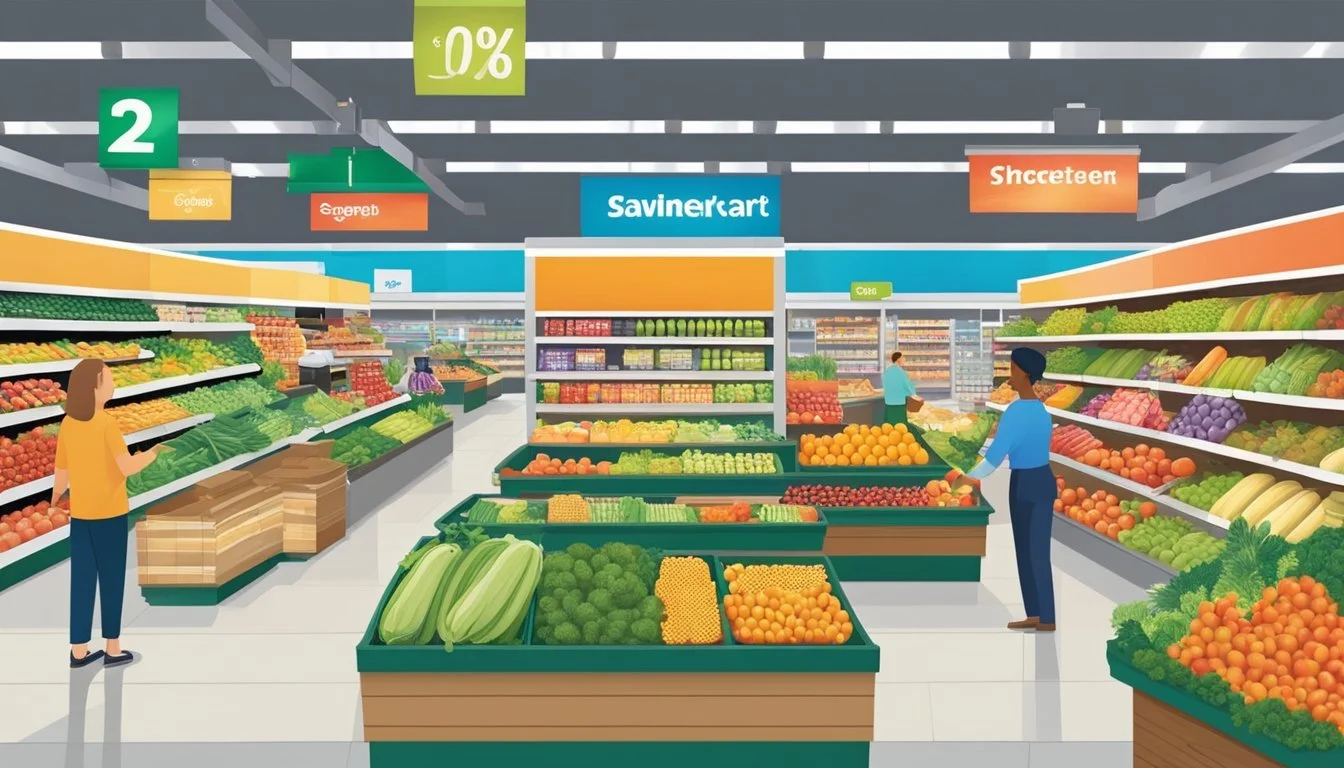Save Mart vs Walmart
A Comprehensive Comparison of Price and Quality
Grocery shopping can be a significant expense for many households, prompting consumers to seek out the best deals. Save Mart and Walmart are two popular options for budget-conscious shoppers. Both stores offer a wide range of products, but they differ in several key aspects.
Walmart typically offers lower prices on groceries compared to Save Mart, with savings averaging around 4-5% on many items. This price advantage stems from Walmart's massive scale and buying power. However, Save Mart often provides a more personalized shopping experience with a focus on fresh, locally-sourced produce and regional specialties.
While Walmart excels in pricing for pantry staples and non-perishables, Save Mart may have an edge in the quality and variety of fresh foods. The choice between these two stores ultimately depends on individual priorities - whether shoppers value rock-bottom prices or a curated selection of fresh goods and local products.
Company Profiles
Save Mart and Walmart are two prominent grocery retailers in the United States, each with a unique history and evolution. These companies have shaped the grocery landscape through their distinct approaches to serving customers and expanding their operations.
History of Save Mart
Save Mart Supermarkets began in 1952 when Nick Tocco and Mike Piccinini opened their first store in Modesto, California. The company focused on providing fresh produce and quality meats to local communities. Save Mart expanded gradually throughout California's Central Valley in the following decades.
In the 1980s and 1990s, Save Mart acquired several regional chains, including Mayfair Markets and Food Max. These acquisitions helped the company grow its presence in Northern California and Nevada. Save Mart also developed its own private label brands to offer customers more affordable options.
By the 2000s, Save Mart had become a significant player in the Western United States grocery market. The company continued to adapt to changing consumer preferences by introducing natural and organic product lines.
History of Walmart
Walmart's journey began in 1962 when Sam Walton opened the first Walmart Discount City in Rogers, Arkansas. The company's early success was built on Walton's strategy of offering low prices and a wide selection of merchandise.
Throughout the 1970s and 1980s, Walmart expanded rapidly across the United States. The company introduced its Supercenter format in 1988, combining general merchandise with a full-service grocery department. This move positioned Walmart as a major competitor in the grocery industry.
In the 1990s, Walmart went international, entering markets in Mexico, Canada, and the United Kingdom. The company also launched its Sam's Club warehouse stores and began developing its e-commerce capabilities.
Today, Walmart is the world's largest retailer and the biggest grocery chain in the United States. The company continues to innovate with initiatives like online grocery pickup and delivery services, cementing its position as a leader in the retail industry.
Store Locations and Accessibility
Save Mart and Walmart differ significantly in their store presence and reach. Save Mart operates regionally while Walmart has a massive national and international footprint. This impacts convenience and shopping options for customers in different areas.
Save Mart Store Presence
Save Mart operates over 200 stores primarily in California and northern Nevada. The company focuses on serving communities in these regions with both urban and rural locations.
Save Mart stores are often found in neighborhood shopping centers and standalone buildings. Many locations offer convenient parking and are accessible by public transportation in larger cities.
The regional focus allows Save Mart to tailor its offerings to local preferences. However, it limits options for customers outside California and Nevada.
Walmart National and International Reach
Walmart boasts over 4,700 stores across all 50 U.S. states. This extensive network makes Walmart highly accessible to most Americans.
Internationally, Walmart operates in 24 countries with over 10,500 stores globally. This massive presence gives Walmart significant economies of scale.
Walmart stores come in several formats:
Supercenters (3,500+ locations)
Neighborhood Markets (700+ locations)
Discount Stores (370+ locations)
The variety of store types allows Walmart to serve both urban and rural areas effectively. Many Walmart locations are open 24/7, enhancing convenience for shoppers.
Product Range Comparison
Save Mart and Walmart offer distinct product selections to cater to different shopper preferences. Their inventories vary in terms of variety, quality, and focus on specific categories.
Save Mart's Product Selection
Save Mart emphasizes fresh produce and quality meats. Their produce section features a wide array of fruits and vegetables, including organic options. The store prides itself on locally sourced items when possible.
Save Mart's meat department offers high-quality cuts and a selection of fresh seafood. Their deli counter provides prepared foods and specialty cheeses.
The store stocks a range of pantry staples and name-brand groceries. While not as extensive as larger retailers, Save Mart's selection aims to meet everyday needs.
Save Mart carries some organic and natural products, though the variety may be more limited compared to specialty stores.
Walmart's Diverse Offerings
Walmart boasts a vast product range across all grocery categories. Their produce section includes both conventional and organic fruits and vegetables at competitive prices.
The store's meat department offers a wide selection of cuts and types, including budget-friendly options. Walmart's dairy section is extensive, featuring both national brands and private label products.
Walmart excels in providing a large variety of pantry items, processed foods, and frozen goods. Their selection caters to diverse dietary needs and preferences.
The retailer offers an expanding range of organic and natural products under their own brands and national labels. Walmart's size allows them to stock niche and specialty items alongside mainstream groceries.
Price Analysis and Affordability
Pricing strategies play a crucial role in grocery shopping decisions. Both Save Mart and Walmart employ different approaches to attract cost-conscious consumers.
Analyzing Save Mart's Pricing
Save Mart focuses on providing competitive prices while maintaining quality. The store offers weekly specials and digital coupons to help customers save money. Save Mart's loyalty program rewards frequent shoppers with personalized discounts and fuel points.
Save Mart often price matches local competitors, ensuring customers get the best deal. The store's private label products offer savings of up to 30% compared to national brands. Fresh produce and meat departments frequently feature promotional prices.
Walmart's Low Price Commitment
Walmart's "Everyday Low Price" strategy is a cornerstone of its business model. The retail giant leverages its massive scale to negotiate lower prices from suppliers. Walmart's grocery prices are typically 5-8% lower than traditional supermarkets.
Walmart's Great Value brand provides budget-friendly alternatives across numerous product categories. The store's price matching policy covers both in-store and online competitors. Walmart+ members enjoy additional benefits like free delivery on groceries.
Walmart's size allows it to absorb temporary price fluctuations, maintaining stable prices for customers. The company's efficient supply chain helps keep costs down, translating to lower shelf prices.
Quality and Freshness
Save Mart and Walmart differ in their approaches to product quality and freshness. Each store has distinct strengths and weaknesses in these areas.
Freshness at Save Mart
Save Mart prioritizes fresh produce and meats. Their produce section features a wide variety of fruits and vegetables, often sourced from local farms when possible. Bananas, spinach, and other popular items are restocked frequently.
The meat department at Save Mart offers high-quality cuts, with butchers on-site to provide custom services. Their organic food selection, while not as extensive as specialty stores, includes fresh options across various categories.
Save Mart's dairy section stocks fresh milk, eggs, and cheese from regional suppliers. The store also maintains strict rotation policies to ensure products remain at peak freshness.
Quality and Freshness at Walmart
Walmart's massive scale allows for competitive pricing, but can impact product freshness. Their produce section offers a wide range, though quality can vary. Some locations struggle with timely restocking of items like bananas and spinach.
Walmart's meat department provides affordable options, but may not match the quality of specialized butcher shops. Their organic food selection has expanded in recent years, offering more choices to health-conscious shoppers.
The store's dairy section stocks major brands alongside Walmart's own Great Value line. While generally fresh, the high turnover can sometimes lead to inconsistent quality in eggs and milk.
Customer Experience and Services
Save Mart and Walmart offer distinct shopping experiences and services tailored to different customer needs. Both stores prioritize convenience and accessibility, but their approaches vary.
Shopping at Save Mart
Save Mart provides a more personalized shopping experience. The store layout is typically more compact, making it easier for shoppers to navigate. Employees are often readily available to assist customers with product inquiries or locating items.
Save Mart offers a grocery pickup service for added convenience. Shoppers can place orders online and collect their groceries at designated times. The pickup process is usually smooth, with staff bringing orders directly to customers' vehicles.
The store focuses on fresh produce and local products, appealing to health-conscious consumers. Save Mart's loyalty program rewards frequent shoppers with personalized discounts and special offers.
What to Expect Shopping at Walmart
Walmart's vast stores offer a wide range of products beyond groceries. The expansive layout can be overwhelming for some shoppers, but clear signage helps with navigation.
Walmart's free grocery pickup service is a standout feature. Customers can order groceries online and select a pickup time. Dedicated parking spots for curbside pickup make the process efficient.
The store's app enhances the shopping experience by providing product locations and digital coupons. Walmart's self-checkout options help reduce wait times at registers.
Walmart's low prices attract budget-conscious shoppers. However, the large store size and high customer volume can lead to longer checkout lines during peak hours.
Store Brands and Exclusive Products
Save Mart and Walmart both offer their own store brands and exclusive products. These options provide customers with alternatives to national brands, often at lower prices.
Save Mart's Exclusive Offerings
Save Mart features its own store brand, "Sunny Select," which covers a wide range of grocery items. This brand offers competitive pricing while maintaining quality standards. Save Mart also carries exclusive local and regional products, catering to regional tastes and preferences.
The store's organic selection includes the "Wild Harvest" line, providing affordable organic options across various categories. Save Mart emphasizes fresh produce and meats, with some locations offering specialty cuts and locally sourced items.
Walmart's Store Brand Portfolio
Walmart boasts an extensive array of store brands, with "Great Value" being its most prominent. This brand spans hundreds of product categories, from pantry staples to household goods. Walmart's "Sam's Choice" offers premium store-brand options in food and beverages.
For health-conscious shoppers, Walmart's "Marketside" brand focuses on fresh, ready-to-eat meals and produce. The "Parent's Choice" line caters to baby and toddler needs. Walmart's store brands often match or exceed the quality of name brands at lower price points.
Walmart's massive scale allows for a broader variety of exclusive products compared to Save Mart. This includes partnerships with celebrities and influencers for limited-time offerings.
Sustainability and Ethical Practices
Both Save Mart and Walmart have made efforts to incorporate sustainability and ethical practices into their operations. These initiatives aim to reduce environmental impact and promote responsible sourcing.
Save Mart's Sustainability Initiatives
Save Mart has implemented several sustainability measures in its stores. The company focuses on energy efficiency, utilizing LED lighting and energy-saving refrigeration systems. Save Mart also emphasizes waste reduction through recycling programs and composting initiatives.
The retailer partners with local farmers to source fresh produce, supporting regional agriculture and reducing transportation emissions. Save Mart offers a selection of organic and natural products, catering to environmentally conscious consumers.
Save Mart has launched reusable bag programs to decrease plastic waste. The company also works with suppliers to ensure ethical sourcing practices and fair labor standards throughout its supply chain.
Walmart's Corporate Responsibility
Walmart has set ambitious sustainability goals as part of its corporate responsibility efforts. The company aims to achieve zero emissions across its global operations by 2040. Walmart has invested in renewable energy, with plans to power 50% of its operations with renewable sources by 2025.
The retail giant has implemented a Sustainability Index to assess product sustainability and encourage suppliers to improve their practices. Walmart's Project Gigaton initiative aims to reduce one billion metric tons of greenhouse gases from its global supply chain by 2030.
Walmart offers a growing selection of organic and sustainable products. The company has committed to more sustainable packaging, aiming to make 100% of its private brand packaging recyclable, reusable, or compostable by 2025.
The retailer has also focused on ethical sourcing, working to improve labor conditions in its supply chain and promote responsible farming practices.
Innovation and Market Trends
Grocery retailers are embracing technology and adapting to changing consumer preferences. Both Save Mart and Walmart are implementing new strategies to stay competitive in the evolving retail landscape.
Save Mart's Adaptation to Consumer Trends
Save Mart has focused on enhancing the shopping experience through digital initiatives. The company introduced a mobile app allowing customers to create shopping lists, access digital coupons, and browse weekly ads.
Save Mart has also expanded its product offerings to cater to health-conscious consumers. The retailer now provides a wider selection of organic, gluten-free, and plant-based options.
To compete with online giants like Amazon and Instacart, Save Mart partnered with Instacart for home delivery services. This move aims to capture a share of the growing e-commerce grocery market.
Walmart's Technological Advancements
Walmart has made significant investments in technology to streamline operations and improve customer experience. The mega-retailer launched Walmart+, a membership program rivaling Amazon Prime, offering free delivery and other perks.
The company expanded its grocery pickup and delivery services, now available at thousands of locations. Walmart also introduced automated pickup towers for online orders, enhancing convenience for customers.
Walmart's app integrates features like Scan & Go, allowing shoppers to skip checkout lines. The retailer is testing autonomous vehicles for deliveries and implementing robotics in warehouses to boost efficiency.
To compete with Whole Foods, Walmart expanded its organic and health-focused product lines. The company also partnered with various meal kit services to cater to busy consumers seeking convenient dining options.
Comparative Analysis
Save Mart and Walmart offer distinct grocery shopping experiences. Their pricing strategies, product selection, and customer service models differ significantly, impacting overall value and convenience for shoppers.
Pricing and Value Comparison
Walmart generally offers lower prices on groceries compared to Save Mart. A typical basket of grocery staples at Walmart costs 2.7% to 5.8% less than at competing stores. This pricing advantage extends to pantry items and home goods.
Save Mart focuses more on quality and local products, which can lead to higher prices. However, they often provide competitive deals on fresh produce and meats.
Walmart's store brands, like Great Value, offer additional savings. These products are usually priced lower than national brands while maintaining acceptable quality.
Both stores run weekly sales and promotions. Walmart tends to have more consistent everyday low prices, while Save Mart may offer deeper discounts on select items.
Service and Convenience Evaluation
Walmart excels in convenience with its extensive grocery pickup service. Customers can order online and collect their groceries without entering the store, saving time.
Save Mart typically provides a more personalized shopping experience. Their stores are often smaller and easier to navigate, with knowledgeable staff available to assist customers.
Walmart's larger stores offer a wider product range, allowing for one-stop shopping. This can be convenient for customers who need to purchase non-grocery items alongside their food shopping.
Save Mart usually has shorter checkout lines and a more relaxed shopping atmosphere. They may offer services like custom meat cutting that aren't available at Walmart.
Both stores have loyalty programs, but Save Mart's tends to be more localized and personalized to regular shoppers.
Conclusion
Save Mart and Walmart both offer advantages for grocery shoppers. Save Mart excels in fresh produce quality and local selections. The store provides a more personalized shopping experience with attentive customer service.
Walmart's key strength lies in its competitive pricing. The retail giant often beats Save Mart on staple grocery items and household goods. Walmart also offers a wider variety of non-food products under one roof.
For budget-conscious shoppers, Walmart may be the better choice. Those prioritizing fresh, local produce and a community-focused atmosphere might prefer Save Mart.
The best option depends on individual preferences and needs. Some shoppers may find value in splitting their purchases between both stores. This strategy allows them to capitalize on each retailer's strengths.
Ultimately, both Save Mart and Walmart have carved out their niches in the grocery market. They continue to attract loyal customers by focusing on their unique selling points.









